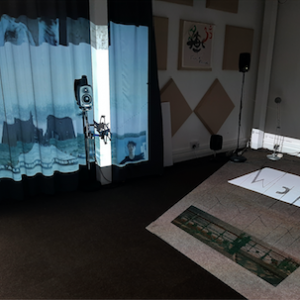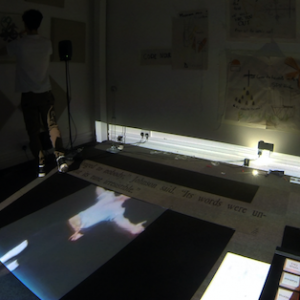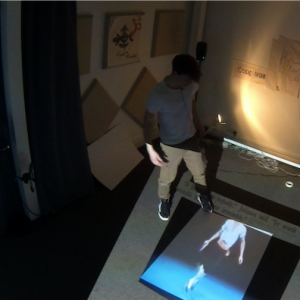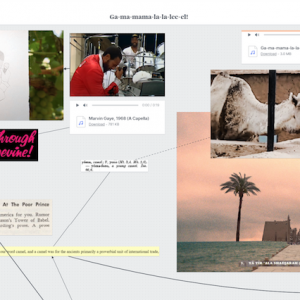“Coming from a science and engineering background I wanted a course that would allow me to focus those skills alongside an arts practice, and the new MA at DMSA seemed to fit the bill. The reputation of the lecturers and previous students too was a draw, the quality and breadth of work emerging from DMSA makes it a really exciting place to study.”
Hi Bob – please tell us a bit about your work and your influences
“I am a coder music producer, hacker, data scientist, educator, VJ, DJ and immersive experience artist operating in a space that weaves spatial sound, education, technology, politics and electronic club culture, into art.”For my final piece I have created ‘ICU’, an immersive interactive sound installation made from a networked collection of interactive devices and custom software that renders data from the faces of the audience and their movements.
Watch the ICU installation trailer:
Watch an ICU example:
Watch a timelapse of the ICU installation set-up:
“14 speakers and 3 screens surround the visitor with sound, light and images. A giant screen with abstract data towers over the visitor. An interactive scenario is projected on two screens that flank a camera reading the visitor’s facial expression. The left screen encourages the visitor to move while sharing their emotion. The right screen projects the extracted data of the visitor and reveals associated images and classifications.
“Synchronously the data harvested by the AI facial recognition system are sonified to reveal the secretive process at work. Sound is spatialised around the visitor, 9 ceiling speakers create a cloud of sound. 5 speakers at ear level create the data sonifications, producing an array of digital crackles and arpeggiated granular melodies.”The system exposes the classifications that allow this machine to understand what it sees. Sound is used to reveal these secretive processes; to create an experiential reflection of the workings of this technology.
“I have been influenced by several artists and researchers in the production of this work. Ryko Ikeda’s ‘Datamatics’ digital installations have been a real inspiration in the aesthetics of the work. The research of Kate Crawford (AI institute/ AI Atlas) and the Liquid Architecture (Eavesdropping) series have helped in the work’s conceptual grounding. My work builds upon the themes explored by those operating under the umbrella term of Surveillance Art such as Trevor Paglean and Jasmine Guffond.”
How have you found your course and time at Brighton?
“Personally the MA has been quite an intense but rewarding journey. As a mature student I chose to study part-time due to having a part time job working in music education and a family to support. With Covid happening and the children having to be homeschooled, time to study has been tight and at times has felt almost overwhelming. But the experience has been very rewarding and it’s not something I regret. The lecturers here have really helped me get the most out of what the course has to offer, and I have come away with so much experience and new skills. Initially I was not sure I could write a thesis again as it was twenty years between my undergraduate and the MA – but thanks to the help of my tutor and the structure of the course my approach to research is a skill that has definitely been refined. It is also something I can use day to day in my work moving forward.”
How did you choose your course – why did you choose to study DMSA?
“I was looking for an experimental music and arts course to expand my practice from purely music and digital works into a more holistic arts practice. Coming from a science and engineering background I wanted a course that would allow me to focus those skills alongside an arts practice, and the new MA at DMSA seemed to fit the bill. The reputation of the lecturers and previous students too was a draw, the quality and breadth of work emerging from DMSA makes it a really exciting place to study.”
What are your plans after graduation?
“I look to continue my programming work with Charanga, a web based music teaching platform, that supported me through my MA. The software I wrote for my final project has some practical applications – such as a musical instrument for those with limited motor skills, and is something I look to explore as a way of helping musicians with physical disabilities. I also am looking to reinstall the final work at various venues around the UK and have applied for various residencies and conferences in the EU over the next year. I also am writing several workshops to teach some of the core concepts of web based audio work. During lockdown I had the opportunity alongside Camp.Fr to write a score ‘The Sound of Surveillance’. This went on to be a part of an essay of impossible scores ‘Hearing the Impossible’ published with Accidental Records last month. This trajectory of work is the inspiration for an E.P. based that hopefully will be finished and released by the end of the year.”







